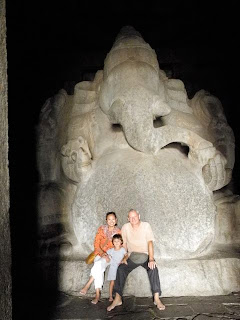Maybe it was all the temple visits making me feel religious and fated to not get there. In addition, I was getting in one of my "I'm-sick-of-traveling-and-being-a-tourist" moods and had no more motivation to plan and arrange transport, hotels and things to see. After purchasing wait listed train tickets, then only getting one seat, attempting to purchase bus tickets but the internet at the tourism office was down, and finally giving up on public transport and sucking it up by hiring a car to get there, we eventually got to Hampi. As usual, in hindsight, I'm glad we made the long trip there because it is another one of those spectacularly, unique places that is in grave danger of being transformed as we speak and will probably not be the same on the next visit. But more about that later.
We also got what we had been missing throughout India (with the exception of Kerala), breathtaking nature. Here is the best of both worlds: the vast Vijayanagara empire (1336 to 1565) of temples, monolithic statues, palaces and systems of water collection engineered from cut stone; running along side it, the Tungabhadra river; and all throughout - a landscape scattered with boulders and emerald-green rice fields to break up the greys, browns and oranges.
 |
| Virupaksha Temple |
 |
| Snuggling with a monolithic Ganesh |
At the Vittala complex, the centerpiece is a lovely chariot with wheels that formerly turned. The central temple itself has large stone pillars with thin columns carved within and the usual set of dancers and characters of the Hindu pantheon.
Then there's the sprawling royal enclosure with its Arab-influenced arched hall, a step well, several pavilions with detailed carvings of royal life and the Ramayana told on a wall enclosing a temple.
 |
| Details of the king's pavilion above |
 | |
| Ramayana in stone |
If the main 25 sq km site is not big enough for you, head over to the other side of the river (also part of the Hampi World Heritage site), Anegundi. If you thought Hampi was gorgeous, it gets even better here! It's much less touristy and with The Kishkinda Trust, it's doing a great effort in empowering local people socially and economically while preserving its cultural and architectural heritage. We met up with its fierce and relentless director, Shama who provided us with a guide for the town. After lunch, at her beautiful home next to the river, she treated Alex to a custom painted bindi.
We opted to stay in the characterful, backpacker-y, scruffy, cow filled area known as the Hampi Bazaar. If you're looking for creature comforts, you won't find them. Basic, family guesthouses are the rule rather than the exception. Foodwise, head to the street for the great eats like gundpangala, dosai, and India's version of the munchkin - all served with a healthy dallop of spicy, coconut chutney.
 |
| Gopi Guesthouse |
 |
| Gundpangala, poori and chutney, aka breakfast! |
 |
| Indian smoutebolle |
But Hampi is undergoing some controversial change these days. Since residents in the main bazaar area live within the stone temples, they are beginning to be forced out of their homes, livelihoods and transferred to a resettlement area away from Hampi proper, all in the name of preservation. Skeptics believe it's a ploy by the government to bring development (read: fancy, expensive hotels and shops) to the area. Here are what the streets look like today but they may look very different in the near future.










































No comments:
Post a Comment